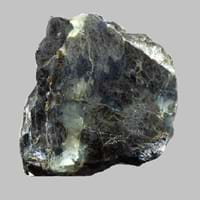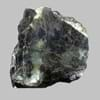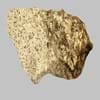Definition
Pyroxenite is a dark, greenish, granular intrusive igneous rock consisting mainly of pyroxenes and olivine
Obsidian is a naturally occurring volcanic glass formed as an extrusive igneous rock. It is produced when felsic lava extruded from a volcano cools rapidly with minimum crystal growth
Discoverer
Unknown
Obsius
Etymology
From pyro- fire + Greek xenos stranger as the mineral group was new to igneous rocks
From Latin obsidianus, misprint of Obsianus (lapis) (stone) of Obsius
Class
Igneous Rocks
Igneous Rocks
Sub-Class
Durable Rock, Hard Rock
Durable Rock, Medium Hardness Rock
Other Categories
Coarse Grained Rock, Opaque Rock
Opaque Rock
Texture
Clastic, Granular, Phaneritic, Porphyritic
Glassy
Color
Black to Grey, Bluish - Grey, Dark Greenish - Grey, Green, Light Greenish Grey
Black, Blue, Brown, Green, Orange, Red, Tan, Yellow
Durability
Durable
Durable
Scratch Resistant
Yes
Yes
Appearance
Layered, Banded, Veined and Shiny
Shiny
Interior Uses
Countertops, Decorative Aggregates, Interior Decoration, Kitchens
Decorative Aggregates, Interior Decoration
Exterior Uses
As Building Stone, As Facing Stone
Garden Decoration
Other Architectural Uses
Curbing
Not Yet Used
Construction Industry
As Dimension Stone, Building houses or walls, Cement Manufacture, Construction Aggregate, for Road Aggregate
Arrowheads, Cutting Tool, Knives, Scrapers, Spear Points
Medical Industry
Not Yet Used
Surgery
Antiquity Uses
Artifacts
Artifacts, Jewellery
Commercial Uses
Cemetery Markers, Commemorative Tablets, Laboratory bench tops, Jewelry, Sea Defence, Tombstones
Creating Artwork, Mirror, Used in aquariums
Types
Clinopyroxenites, Orthopyroxenites and Websterites
Fireworks Obsidian, Mahogany, Sheen Obsidian, Snowflake obsidian and Velvet Peacock Obsidian
Features
Generally rough to touch, Host rock for Diamond, Is one of the oldest rock
Blocks negativity, Helps to protect against depression
Archaeological Significance
Monuments
Not Yet Used
Not Yet Used
Famous Monuments
Not Applicable
Not Applicable
Sculpture
Not Yet Used
Not Yet Used
Famous Sculptures
Not Applicable
Not Applicable
Pictographs
Not Used
Used
Petroglyphs
Not Used
Used
Figurines
Not Yet Used
Not Yet Used
Formation
Pyroxenites are ultramafic igneous rocks which are made up of minerals of the pyroxene group, such as augite and diopside, hypersthene, bronzite or enstatite.
When the lava is released from volcano, it undergoes a very rapid cooling which freezes the mechanisms of crystallization. The result is a volcanic glass with a uniform smooth texture.
Mineral Content
Amphibole, Augite, Bronzite, Chromite, Diopside, Enstatite, Garnet, Hornblende, Hypersthene, Magnetite, Pyroxene
Not Available
Compound Content
Aluminium Oxide, CaO, Chromium(III) Oxide, Iron(III) Oxide, Potassium Oxide, MgO, Sodium Oxide, Silicon Dioxide, Sulfur Trioxide
Aluminium Oxide, CaO, Iron(III) Oxide, FeO, Potassium Oxide, MgO, MnO, Sodium Oxide, Phosphorus Pentoxide, Silicon Dioxide, Titanium Dioxide
Types of Metamorphism
Burial Metamorphism, Impact Metamorphism, Regional Metamorphism
Burial Metamorphism, Cataclastic Metamorphism, Contact Metamorphism
Types of Weathering
Biological Weathering, Chemical Weathering, Mechanical Weathering
Biological Weathering, Chemical Weathering, Mechanical Weathering
Types of Erosion
Chemical Erosion, Coastal Erosion, Water Erosion
Chemical Erosion, Coastal Erosion, Glacier Erosion
Grain Size
Coarse Grained
Not Applicable
Fracture
Uneven
Conchoidal
Streak
White, Greenish White or Grey
White
Porosity
Less Porous
Very Less Porous
Luster
Dull to Vitreous to Submetallic
Vitreous
Compressive Strength
Not Available
Cleavage
Irregular
Non-Existent
Toughness
Not Available
Not Available
Specific Gravity
3.2-3.5
2.6-2.7
Transparency
Opaque
Translucent
Density
3.1-3.6 g/cm3
2.6 g/cm3
Specific Heat Capacity
Not Available
Resistance
Impact Resistant, Pressure Resistant, Wear Resistant
Heat Resistant, Impact Resistant
Deposits in Eastern Continents
Asia
India, Russia
Afghanistan, Indonesia, Japan, Russia
Africa
South Africa
Kenya
Europe
Germany, Greece, Italy, Scotland, Turkey
Greece, Hungary, Iceland, Italy, Turkey
Others
Greenland
Not Yet Found
Deposits in Western Continents
North America
Canada, USA
Canada, Mexico, USA
South America
Brazil, Colombia, Venezuela
Argentina, Chile, Ecuador, Peru
Deposits in Oceania Continent
Australia
New Zealand, Queensland
New Zealand
Pyroxenite vs Obsidian Characteristics
Though some rocks look identical, they have certain characteristics which distinguish them from others. Characteristics of rocks include texture, appearance, color, fracture, streak, hardness etc. Pyroxenite vs Obsidian characteristics assist us to distinguish and recognize rocks. Also you can check about Properties of Pyroxenite and Properties of Obsidian. Learn more about Pyroxenite vs Obsidian in the next section. The interior uses of Pyroxenite include Countertops, Decorative aggregates, Interior decoration and Kitchens whereas the interior uses of Obsidian include Decorative aggregates and Interior decoration. Due to some exceptional properties of Pyroxenite and Obsidian, they have various applications in construction industry. The uses of Pyroxenite in construction industry include As dimension stone, Building houses or walls, Cement manufacture, Construction aggregate, For road aggregate and that of Obsidian include Arrowheads, Cutting tool, Knives, Scrapers, Spear points.
More about Pyroxenite and Obsidian
Here you can know more about Pyroxenite and Obsidian. The life cycle of a rock consists of formation of rock, composition of rock and transformation of rock. The composition of Pyroxenite and Obsidian consists of mineral content and compound content. The mineral content of Pyroxenite includes Amphibole, Augite, Bronzite, Chromite, Diopside, Enstatite, Garnet, Hornblende, Hypersthene, Magnetite, Pyroxene and mineral content of Obsidian is not available. You can also check out the list of all Igneous Rocks. When we have to compare Pyroxenite vs Obsidian, the texture, color and appearance plays an important role in determining the type of rock. Pyroxenite is available in black to grey, bluish - grey, dark greenish - grey, green, light greenish grey colors whereas, Obsidian is available in black, blue, brown, green, orange, red, tan, yellow colors. Appearance of Pyroxenite is Layered, Banded, Veined and Shiny and that of Obsidian is Shiny. Properties of rock is another aspect for Pyroxenite vs Obsidian. The hardness of Pyroxenite is 7 and that of Obsidian is 5-5.5. The types of Pyroxenite are Clinopyroxenites, Orthopyroxenites and Websterites whereas types of Obsidian are Fireworks Obsidian, Mahogany, Sheen Obsidian, Snowflake obsidian and Velvet Peacock Obsidian. Streak of rock is the color of powder produced when it is dragged across an unweathered surface. The streak of Pyroxenite and Obsidian is white, greenish white or grey. The specific heat capacity of Pyroxenite is Not Available and that of Obsidian is 0.92 kJ/Kg K. Depending on the properties like hardness, toughness, specific heat capacity, porosity etc., rocks are resistant to heat, wear, impact, etc.Pyroxenite is impact resistant, pressure resistant, wear resistant whereas Obsidian is heat resistant, impact resistant.





